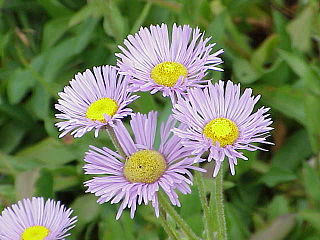
Cirsium is a genus of perennial and biennial flowering plants in the Asteraceae, one of several genera known commonly as thistles. They are more precisely known as plume thistles. These differ from other thistle genera in having a seed with a pappus of feathered hairs on their achenes. The other genera have a pappus of simple unbranched hairs.

Valeriana is a genus of flowering plants in the family Caprifoliaceae, members of which may be commonly known as valerians. It contains many species, including the garden valerian, Valeriana officinalis. Species are native to all continents except Antarctica, with centers of diversity in Eurasia and South America.

Marshallia is a genus of plants in the tribe Helenieae within the family Asteraceae. Marshallia is native to the southeastern and south-central United States. A common name applied to most species in the genus is Barbara's buttons.

Berlandiera is a genus of flowering plants in the family Asteraceae.

Balsamorhiza sagittata is a North American species of flowering plant in the tribe Heliantheae of the family Asteraceae known by the common name arrowleaf balsamroot. Also sometimes called Oregon sunflower, it is widespread across western Canada and much of the western United States.

Pycnanthemum is a genus of herbaceous plants in the mint family (Lamiaceae). Species in this genus are often referred to as "mountain mints" and they often have a minty or thyme-like aroma when crushed. All species of Pycnanthemum are native to the United States and Canada. The center of diversity for the genus is North Carolina with 13 of the 20 species having been collected therein. Nineteen of the 20 species of Pycnanthemum occur in the Eastern US and Canada, and one disjunct species occurs in California and Oregon.

Krigia biflora, also known as two-flower cynthia or two-flower dwarf dandelion, is a species of plant in the family Asteraceae. It is native to North America, where it is found in central Canada and in the eastern, central, and southwestern United States. This species is rare in Connecticut, and it is listed as a species of special concern.

Paronychia argyrocoma, the silvery nailwort or silverling, is a plant species native to the eastern United States. It has a disjunct distribution, found in New England and the Appalachian Mountains of the Southeast but not from New York, New Jersey or Pennsylvania in between. The species grows on rocky sites at elevations of 200–1800 m.

Erigeron pumilus, the shaggy fleabane, or vernal daisy, is a hairy North American species of perennial plants in the family Asteraceae. It is widespread across much of western Canada and the western United States, from British Columbia east to Saskatchewan and south as far as Oklahoma and the San Bernardino Mountains of California. There have been reports of the plant growing in Yukon Territory, but these were based on misidentified specimens.

Ericameria suffruticosa, the singlehead goldenbush, is a subshrub to shrub in the family Asteraceae found in the western United States. "Suffruticosa" means "shrublike".

Astranthium integrifolium, the entireleaf western daisy or eastern western-daisy, is a North American species of flowering plants in the family Asteraceae. It is native to the east-central part of the United States primarily the Cumberland Plateau and Ohio/Tennessee Valley. It is found in the States of Tennessee, Kentucky, Alabama, and Georgia, with isolated populations in Mississippi and West Virginia.
Berlandiera pumila, the soft greeneyes, is a North American species of flowering plant in the family Asteraceae. It is native to the southeastern and south-central United States.
Chrysopsis gossypina, the cottony goldenaster, is a North American species of flowering plant in the family Asteraceae. It is native to the Coastal Plain of the southeastern United States, from eastern Louisiana to southeastern Virginia.

Erigeron glabellus is a North American species of flowering plants in the family Asteraceae, called the streamside fleabane.

Tetraneuris torreyana is a North American species of plants in the sunflower family, known by the common name Torrey's four-nerve daisy. It grows in the western United States, in extreme southern Montana, Arizona, New Mexico, Utah, Colorado, and Wyoming.

Krigia cespitosa, known as common dwarf-dandelion, opposite-leaved dwarf-dandelion, or weedy dwarfdandelion, is a North American species of plant in the family Asteraceae. It is native to northeastern Mexico and to the southeastern and south-central United States, from Florida to Texas and north as far as southeastern Nebraska, southern Illinois, and central West Virginia

Krigia dandelion, known as potato dwarfdandelion, is a North American species of plants in the family Asteraceae. It is native to the southeastern and south-central United States, from the Florida Panhandle to Texas and north as far as Kansas, southern Illinois, and Maryland
Krigia occidentalis, known as western dwarfdandelion, is a North American species of plants in the family Asteraceae. It is native to the southern Great Plains and the Ozark Mountains of the south-central United States.
Krigia wrightii, known as Wright's dwarfdandelion, is a North American species of plants in the family Asteraceae. It is native to the southern Great Plains of the south-central United States.

Leucospora multifida, known variously as Obi-Wan conobea, narrow-leaved paleseed, cliff conobea, cut-leaved conobea, or much-cleft conobea, is an annual herb in the plantain family, Plantaginaceae, and the only species in the North American genus Leucospora.

















